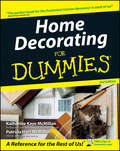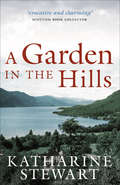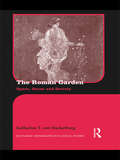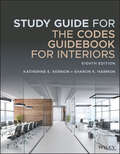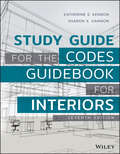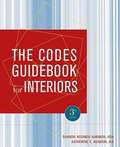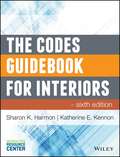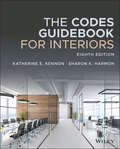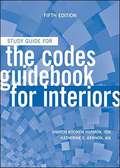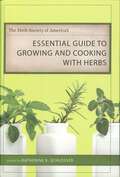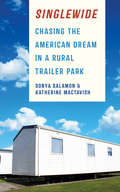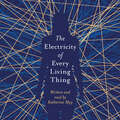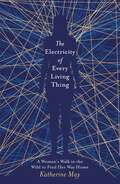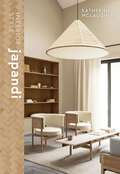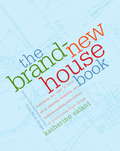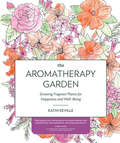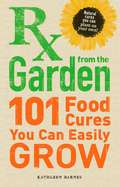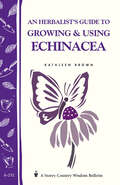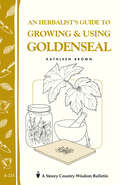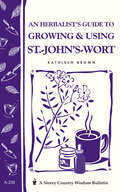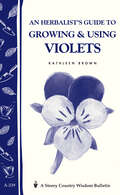- Table View
- List View
Home Decorating For Dummies, 2nd Edition
by Katharine Kaye Mcmillan Patricia Hart McmillanDo you long to create picture-perfect rooms but can't quite seem to achieve them? Do you want better functioning spaces for working, playing, or living? Do you clamor to express your personal style? If you said "yes" to any of these questions, you've turned to the right source for real answers from the pros. Home Decorating For Dummies, 2nd Edition is for all kinds of people in all kinds of decorating situations, including: First-time buyers or renters. You have a whole new place to decorate. Where do you start? Second- or third-time home buyers. Whether you've gone up or down in size, stayed in the same region or moved to a whole new one, you need to know how to make your old furniture work in a new setting, how to add furnishings, and how to make your style seem fresh. Newly blended families. He has furniture, she has furniture, they have furniture. Can it all work together harmoniously? Indeed! And anyone else who loves decorating. Don't forget: Imagination counts. Each part of Home Decorating For Dummies, deals with a broad area of decorating, and each chapter contains specific and detailed information. You'll discover tips on Basic planning - where to begin when you want to start decorating Creating surface interest - the effects of color, pattern, and texture, and the problems created by too much or too little of them Creating backgrounds - what you need to know about the special decorating requirements of your walls Tackling tough rooms - how to effectively decorate rooms that have special functional requirements Accessorizing with art and other stuff - adding the final flourishes to every space in your place Home Decorating For Dummies, 2nd Edition contains all the basics - including how to figure out what you can spend; how to spend it; and the latest and greatest in styles, trends, and technology. What do you do with your space next? The possibilities are endless.
Onward and Upward in the Garden
by Katharine S. WhiteMrs. White loved gardens and spent much time working in hers and writing about all things related. Her husband's introduction to this book is warm and informative.
A Garden in the Hills
by Katharine StewartThe author of the classic A Croft in the Hills takes us through a year in her Scottish Highlands garden and its many delights. This illustrated book celebrates one of humankind&’s oldest pleasures. Month by month, we are taken through a year in the life of Katharine Stewart&’s garden outside the old schoolhouse in Abriachan, Scotland, where she lives with her husband and daughter. The circle of the seasons is luminously evoked as we are told of the practicalities of gardening, cooking, beekeeping, and winemaking. From a winner of a Saltire Society Award for her contribution to the understanding of Scottish Highland culture, and peppered with warm personal insights, good humor, and a love of living things, this account of the joy of nature reminds us how rewarding it is to be outdoors. &“Evocative and charming.&” —Scottish Book Collector
The Roman Garden: Space, Sense, and Society (Routledge Monographs in Classical Studies)
by Katharine T. von StackelbergThis innovative book is the first comprehensive study of ancient Roman gardens to combine literary and archaeological evidence with contemporary space theory. It applies a variety of interdisciplinary methods including access analysis, literary and gender theory to offer a critical framework for interpreting Roman gardens as physical sites and representations. The Roman Garden: Space, Sense, and Society examines how the garden functioned as a conceptual, sensual and physical space in Roman society, and its use as a vehicle of cultural communication. Readers will learn not only about the content and development of the Roman garden, but also how they promoted memories and experiences. It includes a detailed original analysis of garden terminology and concludes with three case studies on the House of Octavius Quartio and the House of the Menander in Pompeii, Pliny’s Tuscan garden, and Caligula’s Horti Lamiani in Rome. Providing both an introduction and an advanced analysis, this is a valuable and original addition to the growing scholarship in ancient gardens and will complement courses on Roman history, landscape archaeology and environmental history.
Study Guide for The Codes Guidebook for Interiors
by Katherine E. Kennon Sharon K. HarmonSTUDY GUIDE FOR THE CODES GUIDEBOOK FOR INTERIORS The comprehensive study guide for understanding interior codes This revised and updated eighth edition of the Study Guide for the Codes Guidebook for Interiors is an essential companion to The Codes Guidebook for Interiors, the industry’s reference of choice. It offers complete coverage of the major codes and standards that apply to interior projects. This Study Guide includes lists of terms, practice questions, practical application exercises, code tables, and checklists. This companion study guide is a comprehensive measure of a designer’s understanding and application of codes for interior projects. It can help design students learn and practitioners keep their skills up to date and prepare for the NCIDQ and ARE exams. It is vital that designers and architects have an up-to-date working knowledge of the various codes involved with building interiors, whether during renovation or new construction, and this study guide offers the opportunity to: Study with many new questions, in both the short answer and application sections Review the key terms of the industry Use the practice questions and exercises to test working knowledge of codes Utilize the code tables during the design process Employ the numerous checklists on proposed and real life projects to ensure complete compliance The revised Study Guide is a useful companion to The Codes Guidebook for Interiors, the essential reference for all interior professionals. For the designer, architect, or student, the Study Guide for The Codes Guidebook for Interiors is a must-have resource.
Study Guide for The Codes Guidebook for Interiors: Wiley E-text Folder And Interactive Resource Center Access Card
by Katherine E. Kennon Sharon K. HarmonThe comprehensive study guide for understanding interior codes This revised and updated seventh edition of the Study Guide for the Codes Guidebook for Interiors is an essential companion to The Codes Guidebook for Interiors, the industry's reference of choice, with complete coverage of the major codes and standards that apply to interior projects. This Study Guide includes term lists, practice questions, practical application exercises, code tables, checklists, and a book companion site featuring interactive checklists, helping designers and architects check their knowledge and comprehension from reading The Codes Guidebook for Interior chapters and prepare for the NCIDQ and ARE exams. Since The Codes Guidebook for Interiors text covers the latest requirements, standards, terminology, and federal regulations, including the 2015 ICC, the current ADA standards, and ICC/ANSI requirements as well as information on green construction, this companion study guide is a comprehensive measure of designers understanding and application of codes for interior projects. It can help design students learn and practitioners keep their skills up to date. Because it is vital that designers and architects have an up-to-date working knowledge of the various codes involved with building interiors, whether during renovation or new construction, the study guide offers them an opportunity to: Check their knowledge of the key terms of the industry Test their working knowledge of codes using the practice questions and problem scenarios Utilize the code tables during the design process Employ the numerous checklists on proposed and real life projects to ensure complete compliance The revised Study Guide is a useful companion to The Codes Guidebook for Interiors, the essential reference for all interior professionals. Check your understanding of the individual chapters as exam prep or even just as a self-test. For the designer, architect, or student, the Study Guide for The Codes Guidebook for Interiors is a must-have resource.
The Codes Guidebook for Interiors
by Sharon Koomen Harmon Katherine E. KennonThe Codes Guidebook for Interiors, Fifth Edition features jargon-free explanations of all the codes and standards of concern to designers and architects, including performance codes, fire codes, building and finish standards, energy codes, and Americans with Disabilities standards. The book uses an easy-to-navigate format that is geared towards the code process as a whole, to take readers step-by-step through the codes relevant at each stage in the design process. Dozens of examples and a greatly enhanced set of illustrations, show how codes apply to real-world projects.
The Codes Guidebook for Interiors
by Katherine E. Kennon Sharon K. HarmonThe Interactive Resource Center is an online learning environment where instructors and students can access the tools they need to make efficient use of their time, while reinforcing and assessing their understanding of key concepts for successful understanding of the course. An access card with redemption code for the online Interactive Resource Center is included with all new, print copies or can be purchased separately.(***If you rent or purchase a used book with an access code, the access code may have been redeemed previously and you may have to purchase a new access code (ISBN: 9781118990179).The online Interactive Resource Center contains resources tied to the book, such as:Interactive Forms and ChecklistsDownloadable BibliographyFlashcards by chapter for focused learningGet up to speed on the latest codes with the complete reference for interiors.The Codes Guidebook for Interiors, Sixth Edition is the standards reference of choice for designers and architects, and the only guide devoted exclusively to codes applicable to interiors. With jargon-free explanations of all standards and regulations of concern to designers and architects, the book takes readers step-by-step through the codes relevant to each stage in the design process. The updated sixth edition features the latest information on fire codes, performance codes, building and finish standards, energy codes, and accessibility regulations, plus enhanced illustrations that clearly demonstrate how codes apply in real-life scenarios.Interior designers, architects, and facility managers need a basic understanding of the various codes involved with building interiors. These codes are updated on a continuous basis, and professionals must stay on top of new requirements and upcoming codes processes. The Codes Guidebook for Interiors is a complete reference, organized by stage for easy navigation, and comprehensive enough for use as a review for the NCIDQ and ARE exams. The sixth edition contains the most recent developments in interior codes and regulations, including:2012 ICC codes, including the IBC, and ICC International Green Construction CodeCoverage of changes to ADA standards and ICC/ASI accessibility requirementsNew standards, terminology, and federal regulationsUpdated information on sustainability as it relates to codes and regulations Having all applicable codes in a single resource saves hours of research time, and can dramatically reduce the potential for costly planning oversights. Whether renovation or new construction, small or large, codes apply to every project. The Codes Guidebook for Interiors provides designers with the comprehensive information they need to stay up-to-date.
The Codes Guidebook for Interiors
by Katherine E. Kennon Sharon K. HarmonTHE INTERIOR CODES AND STANDARDS REFERENCE OF CHOICE FOR DESIGNERS AND ARCHITECTS—UPDATED FOR THE 2018 AND 2021 CODES If you are involved with the design or management of buildings and spaces, it is important to remain up-to-date on the ever-evolving codes and standards that keep communities safe. With over 80,000 copies sold, The Codes Guidebook for Interiors continues to provide comprehensive explanations of the major codes and standards applicable to commercial and residential interior projects. The easily navigable format gives clear perspective to how these often confusing concepts and requirements are integrated into real world practice, helping designers incorporate the relevant standards into their projects. Updated with the most recent changes and insights to the codes and standards of the ICC, NFPA, ANSI, ADA, and other standards, the Eighth Edition provides unparalleled and integrated guidance on building safety, accessibility, sustainability, energy efficiency, and more. Updates to the Eighth Edition include: Explanations of code requirements, highlighting the latest changes in the 2018 and 2021 ICC codes, including the International Building Code and the NFPA’s Life Safety Code Clarifications to how and when the ADA, ABA and the ICC/ANSI accessibility requirements will apply to a project Introduction to the codes and standards that address sustainability in typical projects In-depth examinations of fire and smoke resistant assemblies, fire protection systems, and plumbing and mechanical requirements A companion website with printable study flashcards, instructor’s manual, and PowerPoint slides for use in academic settings Digital and printable code checklists that can guide code research for professional projects and use in a design studio Current, practical, and relevant to nearly any interior or architectural project, The Codes Guidebook for Interiors provides invaluable insight and reference for both student and professional interior designers and architects.
The Codes Guidebook for Interiors, Study Guide
by Sharon Koomen Harmon Katherine E. KennonThe Codes Guidebook for Interiors, Fifth Edition features jargon-free explanations of all the codes and standards of concern to designers and architects, including performance codes, fire codes, building and finish standards, energy codes, and Americans with Disabilities standards. The book uses an easy-to-navigate format that is geared towards the code process as a whole, to take readers step-by-step through the codes relevant at each stage in the design process. Dozens of examples and a greatly enhanced set of illustrations, show how codes apply to real-world projects.
The Codes Guidebook for Interiors: Wiley E-text Folder And Interactive Resource Center Access Card
by Katherine E. Kennon Sharon K. HarmonInterior codes and standards reference of choice for designers and architects, updated and revised Completely revised and updated, the seventh edition of The Codes Guidebook to Interiors is the only book devoted exclusively to codes that are applicable to interior designers. The guide features jargon-free explanations of all the codes and standards that are relevant to designers and architects, including performance codes, building and finish standards, energy codes, and ADA standards. In addition, the dozens of examples and a greatly enhanced with a set of illustrations, including floor plans, that clearly show how codes apply to real-world project. Written by Katherine E. Kennon (a professional architect and facilities planner) and Sharon Koomen Harmon (a professional interior designer and educator) are experts on interior design and architecture codes. Updated coverage contains the most recent ICC codes, including the International Building Code and new material on the ICC International Green Construction Code, as well as the NFPA's most recent Life code. The authors address a wide-variety of building and project types (large and small) and they offer information on single family homes and historical and existing buildings. The seventh edition includes: Easy-to-navigate format geared toward the code process as a whole A step-by-step guide through the codes relevant at each stage in the design process The newest changes to the ADA Standards and ICC/ASI accessibility requirements A companion site that offers interactive checklists, flashcards, PowerPoint lecture slides, and an Instructor's Manual Having all applicable codes in a single resource saves hours of research time, and can dramatically reduce the potential for costly planning oversights. Whether renovation or new construction, small or large, codes apply to every project. The Codes Guidebook for Interiors provides designers with the comprehensive information they need to stay up-to-date.
The Herb Society of America's Essential Guide to Growing and Cooking with Herbs: A Novel (Voices of the South)
by Katherine K. SchlosserFresh herbs offer a healthy and delicious way to spice up any meal, but growing and cooking with these delectable plants are endeavors fraught with uncertainty. What herbs will grow year-round on my kitchen windowsill? What foods complement rosemary? Which part of a lemongrass plant has the best flavor? Can I really eat the geraniums growing in my flower bed? This indispensable guide from The Herb Society of America takes the guesswork out of using herbs in the garden and in the kitchen by providing detailed information for cultivating a wide variety of herbs, along with easy-to-follow recipes that will surely impress even the most discerning palate. Ranging from Alliums (onions, chives, and garlic) to Zingiber (ginger), the volume's first section provides horticultural information for each of the sixty-three herbs found in the National Herb Garden's Culinary Garden, including common and botanical names, family, place of origin, hardiness, and general light and soil requirements. Botanical sketches accompany many of the entries. Each entry also includes a short history of the herb, gardening basics, and suggestions for using the herb in your kitchen. Culinary herbs without Generally Recognized as Safe (GRAS) Status are included in a separate section, with an explanation of their history and ornamental value. An informative introduction to this section compares several different definitions of the word herb, explains the advantages of fresh over dried herbs, describes the proper storage and use of spices, and suggests the best timing and methods for harvesting herbs. In the second part of the book, HSA members offer classic and creative recipes for more than two hundred dishes incorporating a variety of herbs. Learn how to use the aromatic and flavorful herbs in your garden to enhance stews and casseroles, create dips and pestos, and add a new dimension to your favorite liqueurs. Among the mouth-watering recipes featured are Lemon Basil Tea Bread, Chicken Linguine with Fennel and Tarragon, Five-Herb Pasta Salad, and Rosemary Fizz.The concluding section of the book contains a fascinating personal tour of the two-and-one-half-acre National Herb Garden, which lies in the heart of Washington, D.C., at the center of the United States National Arboretum, and of its various themed areas, including the Knot Garden, the Antique and Heritage Rose Garden, the Dye Garden, the Colonial Garden, the Native American Garden, the Beverage Garden, the Medicinal Garden, and many others. Complete plant lists accompany the description of each garden.Green thumbs and gourmets alike will find inspiration in these pages to look at herbs in new ways -- perhaps to see beyond their cupboards and into their own yards for ways to liven up their meals -- and will gain the knowledge and confidence to grow and use herbs effectively. More than a gardening book, more than a cookbook, The Herb Society of America's Essential Guide to Growing and Cooking with Herbs will prove to be an indispensable companion for all herb lovers.
Singlewide: Chasing the American Dream in a Rural Trailer Park
by Sonya Salamon Katherine MacTavishIn Singlewide, Sonya Salamon and Katherine MacTavish explore the role of the trailer park as a source of affordable housing. America’s trailer parks, most in rural places, shelter an estimated 12 million people, and the authors show how these parks serve as a private solution to a pressing public need. Singlewide considers the circumstances of families with school-age children in trailer parks serving whites in Illinois, Hispanics in New Mexico, and African Americans in North Carolina. By looking carefully at the daily lives of families who live side by side in rows of manufactured homes, Salamon and MacTavish draw conclusions about the importance of housing, community, and location in the families’ dreams of opportunities and success as signified by eventually owning land and a conventional home. Working-poor rural families who engage with what Salamon and MacTavish call the "mobile home industrial complex" may become caught in an expensive trap starting with their purchase of a mobile home. A family that must site its trailer in a land-lease trailer park struggles to realize any of the anticipated benefits of homeownership. Seeking to break down stereotypes, Salamon and MacTavish reveal the important place that trailer parks hold within the United States national experience. In so doing, they attempt to integrate and normalize a way of life that many see as outside the mainstream, suggesting that families who live in trailer parks, rather than being "trailer trash," culturally resemble the parks’ neighbors who live in conventional homes.
The Electricity of Every Living Thing: A Woman's Walk in the Wild to Find Her Way Home
by Katherine MayLast summer, Katherine May was approaching 40, feeling overwhelmed by motherhood and lacking connection with others, lost in a world of inundation and expectation. She had always felt different but this feeling was new. She wanted to get out, get free and find herself again - and so set about walking the rugged 450 mile South West Coast Path. However, this journey uncovers more than she ever imagined. By chance, en route to the walk, Katherine hears a radio show and the guests are speaking about Asperger's Syndrome. Things begin to fall into place - could this explain the white-outs, the excruciating confusion around social contact, the electric feeling of every living thing?After a formal diagnosis, Katherine begins to unravel this new perspective of her life. Through her physical journey comes an emotional one - of accepting who she is and moving forward. It's not just about walking or Asperger's; this is one woman's journey to feel free within herself, something that everyone can relate to.Read by Nathalie Buscombe(p) Orion Publishing Group 2018
The Electricity of Every Living Thing: From the bestselling author of Wintering
by Katherine MayFrom the bestselling author of Wintering, Katherine May, The Electricity of Every Living Thing is a life-affirming and poignant exploration of nature, and how reconnecting to wild landscapes can create peace in our unquiet minds.'A windswept tale, beautifully told' Raynor Winn, author of The Salt Path 'A manifesto for the value of difficult people. I loved it' Amy Liptrot, author of The OutrunIn August 2015, Katherine May set out to walk the 630-mile South West Coast Path. She wanted to understand why she had stopped coping with everyday life; why motherhood had been so overwhelming and isolating, and why the world felt full of inundation and expectations she can't meet. Setting her feet down on the rugged and difficult path by the sea, the answer begins to unfold.The Electricity of Every Living Thing tells the story of the year in which Katherine comes to terms with a diagnosis which shakes her to her core. It leads to a re-evaluation of her life so far - a kinder one, which finally allows her to be different rather than simply awkward, arrogant or unfeeling. The physical and psychological journeys become inextricably entwined, and as Katherine finds her way across the untameable coast, she also finds the way to herself.What readers are saying about The Electricity of Every Living Thing:'Honest and sensitive' 'The astonishing sensitivity and awareness in her writing, both about the beautiful landscapes and nature around on her walks, and in relation to her family, friends and self put paid to many outdated myths about what it is like to be autistic''Compelling and transformative. I could not put this book down so I stayed in bed and read it in one go.''Katherine has a fantastic way with words, I could read her books for hours on end, they are calming and relatable.''Read it - you won't regret it.'
Interior Style: Japandi (Interior Styles)
by Katherine McLaughlinCapture the Japanese-meets-Scandi trend with in-depth practical advice on how to use colour, texture, lighting and more, all accompanied by images of gorgeous interiors and inspirational showpiece homes.A fusion of functional Eastern minimalism with clean Scandi cosiness, the japandi interior style creates a tranquil home with its focus on warmth, simplicity, natural elements and muted colours. Elements such as bamboo, wood and stone, along with clean lines and uncluttered spaces make a restful environment. With a historical overview of the decor, and illustrated with examples of notable interiors and key elements of lighting, furniture, colour palette, texture and textile, Japandi offers practical advice on how to recreate the look in your own home.With a historical overview of the decor, and illustrated with examples of notable interiors and key elements of lighting, furniture, colour palette, texture and textile, the book offers practical advice on how to recreate the look in your own home.
Interior Style: Japandi (Interior Styles)
by Katherine McLaughlinCapture the Japanese-meets-Scandi trend with in-depth practical advice on how to use colour, texture, lighting and more, all accompanied by images of gorgeous interiors and inspirational showpiece homes.A fusion of functional Eastern minimalism with clean Scandi cosiness, the japandi interior style creates a tranquil home with its focus on warmth, simplicity, natural elements and muted colours. Elements such as bamboo, wood and stone, along with clean lines and uncluttered spaces make a restful environment. With a historical overview of the decor, and illustrated with examples of notable interiors and key elements of lighting, furniture, colour palette, texture and textile, Japandi offers practical advice on how to recreate the look in your own home.With a historical overview of the decor, and illustrated with examples of notable interiors and key elements of lighting, furniture, colour palette, texture and textile, the book offers practical advice on how to recreate the look in your own home.
The Brand-New House Book
by Katherine SalantFrom the first vague ideas to the finished structure, building a brand-new house presents you with thousands of choices -- and possible pitfalls. Yet there's no single expert you can turn to at every stage and ask, "What do I do?" Until now. This definitive reference will help you:* Figure out how much house you need, and how much you can afford* Choose among types of builders, communities, and lots* Negotiate the offer, financing, contract, and closing* Assess options and upgrades -- which are worth it and which are not* Understand windows, flooring, kitchens, landscaping, and scores of other issues* Work with real-estate agents, architects, site superintendents, home inspectors, attorneys -- your whole team, which may consist of dozens of playersThe Brand-New House Book distills the most crucial advice from hundreds of experts -- from the broad strokes such as bankers on mortgages, interior designers on colors, or arborists on trees to fine-tuning such as cleaners on carpets, movers on staircases, or landscape architects on drainage, every issue is addressed. Thorough and authoritative, yet completely accessible, this book is the most valuable investment you can make to ensure that you bypass the potential nightmares and ultimately come home to the house of your dreams.
Rome
by Spiro Kostof Rabun Taylor Rinne Katherine WentworthSpanning the entire history of the city of Rome from Iron Age village to modern metropolis, this is the first book to take the long view of the Eternal City as an urban organism. Three thousand years old and counting, Rome has thrived almost from the start on self-reference, supplementing the everyday concerns of urban management and planning by projecting its own past onto the city of the moment. This is a study of the urban processes by which Rome's people and leaders, both as custodians of its illustrious past and as agents of its expansive power, have shaped and conditioned its urban fabric by manipulating geography and organizing space; planning infrastructure; designing and presiding over mythmaking, ritual, and stagecraft; controlling resident and transient populations; and exploiting Rome's standing as a seat of global power and a religious capital.
The Aromatherapy Garden: Growing Fragrant Plants for Happiness and Well-Being
by Kathi Keville“Kathi guides you to all the joys of an aromatic garden with wonderful tips, fascinating facts, and sumptuous photos.” —Mandy Aftel, acclaimed natural perfumer and author of Essence and Alchemy and FragrantThe Aromatherapy Garden explains how fragrant plants can be as therapeutic as they are intoxicating, and how easy it is to add this captivating element to gardens large and small. It reveals the scents, secrets, and science behind fragrant plants, and how to optimize the full benefits of fragrance. Hone your powers of concentration with lemon verbena. Beat the blues with wintersweet. And use rose geranium to relieve anxiety and stress. Revealed here are the scents, secrets, and science behind plant aromatherapy, and how to optimize its full benefits. Detailed plant profiles will help you create a beautiful source of restorative aromas, oils, sachets, teas, and more. The nose knows—and with Keville’s expertise, now you too can create your own sanctuary of health and happiness
RX from the Garden: 101 Food Cures You Can Easily Grow
by Kathleen BarnesYour backyard becomes an all-natural pharmacy!Colds. Headaches. Upset stomach, Allergy symptoms. Depression. Circulation problems.This timely book goes beyond using herbs as medicine; it also focuses on beneficial foods for more than 100 common ailments and shows you how to grow them.In that way, RX from the Garden lets you circumvent expensive meds with questionable side effects by explaining what foods to eat to help you feel better. In addition to aligning health problems with natural cures, this valuable resource provides step-by-step instruction on how to easily cultivate the corresponding vegetables and herbs in your lawn, garden, or flowerbed.According to Hippocrates, "Our food should be our medicine. Our medicine should be our food." Now you can reap health benefits for your very own backyard bounty.
An Herbalist's Guide to Growing & Using Echinacea: A Storey Country Wisdom Bulletin (Storey Country Wisdom Bulletin Ser.)
by Kathleen BrownSince 1973, Storey's Country Wisdom Bulletins have offered practical, hands-on instructions designed to help readers master dozens of country living skills quickly and easily. There are now more than 170 titles in this series, and their remarkable popularity reflects the common desire of country and city dwellers alike to cultivate personal independence in everyday life.
An Herbalist's Guide to Growing & Using Goldenseal: Storey's Country Wisdom Bulletin A-233 (Storey Country Wisdom Bulletin Ser.)
by Kathleen BrownSince 1973, Storey's Country Wisdom Bulletins have offered practical, hands-on instructions designed to help readers master dozens of country living skills quickly and easily. There are now more than 170 titles in this series, and their remarkable popularity reflects the common desire of country and city dwellers alike to cultivate personal independence in everyday life.
An Herbalist's Guide to Growing & Using St.-John's-Wort: Storey Country Wisdom Bulletin A-230 (Storey Country Wisdom Bulletin Ser.)
by Kathleen BrownSince 1973, Storey's Country Wisdom Bulletins have offered practical, hands-on instructions designed to help readers master dozens of country living skills quickly and easily. <P><P>There are now more than 170 titles in this series, and their remarkable popularity reflects the common desire of country and city dwellers alike to cultivate personal independence in everyday life.
An Herbalist's Guide to Growing & Using Violets: Storey Country Wisdom Bulletin A. 239
by Kathleen BrownSince 1973, Storey's Country Wisdom Bulletins have offered practical, hands-on instructions designed to help readers master dozens of country living skills quickly and easily. There are now more than 170 titles in this series, and their remarkable popularity reflects the common desire of country and city dwellers alike to cultivate personal independence in everyday life.
